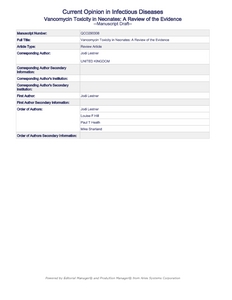Lestner, JM; Hill, LF; Heath, PT; Sharland, M
(2016)
Vancomycin toxicity in neonates: a review of the evidence.
Current Opinion in Infectious Diseases Online, 29 (3).
pp. 237-247.
ISSN 1473-6527
https://doi.org/10.1097/QCO.0000000000000263
SGUL Authors: Sharland, Michael Roy Hill, Louise Frances
![[img]](https://openaccess.sgul.ac.uk/107752/1.hassmallThumbnailVersion/Vancomycin_manuscript.pdf)  Preview |
|
PDF
Accepted Version
Available under License ["licenses_description_publisher" not defined].
Download (658kB)
| Preview
|
Abstract
PURPOSE OF REVIEW: Vancomycin is a first-line agent in the treatment of serious Gram-positive infections in the neonatal population. The published evidence on vancomycin toxicity in neonates is limited. This review summarizes preclinical studies and clinical trials describing vancomycin toxicity. We discuss proposed pathophysiology and summarize evidence supporting dose-response relationships, genetic and environmental determinants, and consider future research required to further define vancomycin toxicity. RECENT FINDINGS: Current dosing regimens for vancomycin result in subtherapeutic levels in a large proportion of patients. Higher daily doses have been proposed, which have led to concerns regarding increased toxicity. Nephrotoxicity occurs in 1-9% of neonates receiving currently recommended doses. The incidence is highest in those receiving concomitant nephrotoxic drugs. Vancomycin-associated ototoxicity is rare in patients of all ages. Exposure-toxicity relationships in relation to nephrotoxicity and ototoxicity have not been clearly defined in neonates receiving vancomycin. SUMMARY: Current evidence supports the favourable safety profile of vancomycin in neonates. Further studies that address safety concerns relating to high-dose intermittent dosing regimens are needed. Such studies must include robust and standardized definitions of renal and hearing impairment, and include follow-up of sufficient length to establish the long-term implications of experimental findings.
Statistics
Item downloaded times since 04 May 2016.
Actions (login required)
 |
Edit Item |



